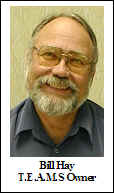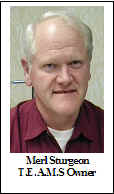T.E.A.M.S
Example of the New Forest Service
U.S. Forest Service
 For
the past five years, the Forest Service has successfully followed a new
vision for how it can do its work; small businesses within. If you go into
a National Forest today, you might find Ron O'Hanlon of Vegetation
Management Solutions enterprise evaluating harvest strategies in a
proposed fuels reduction project. Cam Lockwood of Trails Unlimited
enterprise might train a group of employees on trail location and
construction considerations. Bill Hay and Merl Sturgeon of T.E.A.M.S
enterprise might discuss with a District Ranger a check cruise they have
just prepared. These Forest Service entrepreneurs own small businesses
within the Forest Service. They contract with National Forests and other
government agencies to provide their services at full cost recovery. For
the past five years, the Forest Service has successfully followed a new
vision for how it can do its work; small businesses within. If you go into
a National Forest today, you might find Ron O'Hanlon of Vegetation
Management Solutions enterprise evaluating harvest strategies in a
proposed fuels reduction project. Cam Lockwood of Trails Unlimited
enterprise might train a group of employees on trail location and
construction considerations. Bill Hay and Merl Sturgeon of T.E.A.M.S
enterprise might discuss with a District Ranger a check cruise they have
just prepared. These Forest Service entrepreneurs own small businesses
within the Forest Service. They contract with National Forests and other
government agencies to provide their services at full cost recovery.
In October, Bill Hay and Merl Sturgeon
sponsored a 3P and Variable Plot Workshop for the Forest Service at North
Lake Tahoe. The Forest Service has developed new, more stringent sampling
error standards for selling trees that won't meet sawlog specifications.
Bill and Merl recognized that new Forest Service cruisers need training in
the efficient methods for meeting these stringent standards. They
partnered with the Pacific Southwest Forest Service Region Natural
Resource Management Staff to host this workshop. Their enterprise,
T.E.A.M.S, sponsored the tuition for all 35 class participants from the
Pacific Southwest Region and set up the workshop. They donate a percentage
of their net income to improve agency programs. The Pacific Southwest
Region provided the logistical support for the field exercises and for the
national cruise software. This partnership demonstrates one of the many
benefits the Forest Service has received from these internal businesses.
Let's take a closer look at T.E.A.M.S.
 What
is an enterprise in the Forest Service? What
is an enterprise in the Forest Service?
An enterprise within the Forest Service is a
group of Forest Service employees who operate like a business. They market
their services to government clients while operating under the same rules
as other Forest Service employees. Their fees cover all direct and
indirect costs of operating their business. No appropriated money is given
directly to an enterprise; they must cover all their costs through their
bill rates. They operate on the free market principles of supply and
demand. The Forest Service has provided them with the freedom to decide
which work they will do and which they refuse. Each enterprise must show a
positive net income and benefits to the Forest Service. Each enterprise
presents an annual report and an updated business plan each year to the
Enterprise Steering Committee, a committee made up of Forest Service line
officers and key staff from participating Regions and the Washington
Office. The Enterprise Steering Committee licenses and monitors
enterprises.
How does T.E.A.M.S benefit the Forest
Service?
The Forest Service has downsized over the past
decade and a half. National Forests generally have enough employees to do
their normal workload. But, when they have an emergency such as a fire,
windstorm or insect attack, they must look for outside help. Twenty years
ago they had enough people to borrow from other Forest Service units. They
don't have that ability now. They must hire more people, use contractors
from outside of the Forest Service, or use an enterprise such as T.E.A.M.S.
The line officer still decides whether they will hire, use a contractor or
an internal enterprise. They have no obligation to use an internal
enterprise. Some do use T.E.A.M.S. They like using an internal Forest
Service enterprise because we understand their needs, we use a convenient
internal work order as our contract, and we have a good reputation.
The Forest Service has many benefits from using
an internal enterprise like T.E.A.M.S.:
-
Choice - we provide an alternate
choice for Forest Service units to obtain support and services.
-
Financial Accountability - we
receive no direct appropriated funds. We must financially sustain our
enterprise from contracts with our clients. As such, we have a
heightened awareness of costs, delivery of quality, and gains in
efficiencies.
-
Work with a Purpose - we do not work
for profit like commercial businesses. We work for the purpose of
contributing to the Forest Service Mission, and through our training
and experience exercise a discriminating awareness of effectiveness
and efficiencies.
-
Spreading Cost Awareness - we
frequently expose Forest Service units that utilize our services to
how we recognize expenses and calculate rates of cost recovery used to
estimate project costs. This begins the expansion of true cost
recognition beyond the nucleolus of our enterprise.
What services does T.E.A.M.S offer?
T.E.A.M.S offers turnkey project planning,
implementation, and quality control services. Planning services include
resource inventories, hydrology, wildlife, botany, soils, archeology,
silviculture and other specialist's reports and writing documents that
meet the requirements of the National Environmental Policy Act.
Implementation services include project layout, marking, cruising,
appraisal, and contract preparation. Quality control services include
check scaling, check cruising, log accountability audits, timber sale
administration and stewardship contract administration. T.E.A.M.S provides
these services individually or as a turnkey solution.
Who uses these services?
T.E.A.M.S competes for work from any government
agency. While we can compete with private industry for government work, we
cannot compete with private industry for jobs in the private sector.
T.E.A.M.S currently has projects with National Forests in all 9 Regions,
Bureau of Land Management, State of Idaho Fish and Game, and Bureau of
Indian Affairs.
How many Forest Service employees does
T.E.A.M.S have and where are they?
T.E.A.M.S has 95 permanent employees and about
50 temporary employees. Because we do not have the hiring flexibility of
private companies, we contract one-third of our work to private companies
and other enterprises. Contracting allows us workforce flexibility to
respond to supply and demand forces of free enterprise.
Employees of T.E.A.M.S work from their offices
throughout the United States. We do not move our employees into a single
office because our employees travel to their projects. We leave our
employees at the location where we hire them to save costs and to provide
us with a larger job applicant pool. Our crews are on-the-road year long
and don't need a central office. Our planning employees have an office
near their home. We give each employee a laptop computer and a cell phone.
We communicate at our client's offices, by conference calls, and using
internet tools such as NetMeeting and email. We maintain employee
accountability by using a system that compares planned work to
accomplishment. We offer our employees autonomy, the satisfaction of
having specific projects that they can complete, and responsibility for
how they do the job. Price-Waterhouse-Cooper surveys have shown our
employees enjoy working for T.E.A.M.S more than working at mainstream
Forest Service positions.
Do we have examples of our work?
On the Ouachita National Forest in 2002, we
assisted the Tiak Ranger District to inventory standing trees on about
7,000 acres of newly acquired plantations. The district's small timber
staff had little awareness of Global Positioning (GPS) to measure acreage.
T.E.A.M.S finished the inventory on time and provided training to district
personnel on GPS use. They were amazed by GPS technology and by the
computer generated unit maps that we produced. They also appreciated the
speed with which we completed the project. They contracted with us to
produce additional timber sales in FY 03.
Overwhelmed with lands projects and oil and gas
proposals that needed National Environmental Policy Act (NEPA) plans, the
Medicine Bow National Forest asked T.E.A.M.S to provide wildlife and
hydrology short-term assistance. The Forest had started the 9-12 month
process to fill vacancies, but they needed to move forward with their
projects in the interim. Marynell Oechsner, T.E.A.M.S wildlife biologist,
provided wildlife reports for five lands projects. She also provided
biological oversight to private contractors working on the Thunderhead
Coal Bed Methane project. Alice Allen, T.E.A.M.S Interdisciplinary Team (IDT)
Leader, led IDTs composed of specialists from the Forest, T.E.A.M.S and
private contractors on several coal bed methane developments. She also
provided a wildlife feasibility report for a 33,000 acre Wyoming State
land exchange. Cavan Maloney, T.E.A.M.S hydrologist, provided hydrology
reports and NEPA oversight on these projects. The Medicine Bow moved ahead
with their projects despite critical personnel shortages. The Forest was
so pleased with the products and personnel provided that they have signed
a new contract with T.E.A.M.S.
What's ahead?
The Forest Service will expand enterprises
during 2004. Current Regions sponsoring enterprise units include Pacific
Southwest, Southwest and Pacific Northwest Regions. As part of this
expansion, T.E.A.M.S will offer franchise opportunities to Forest Service
employees. Under the wing of a successful enterprise, new entrepreneurs
will have the benefit of operating with a successful strategy and the
security of a supporting organization. T.E.A.M.S truly represents a new
Forest Service vision, a vision that makes the Government agency more
effective and efficient.
|